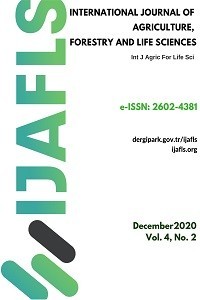DEVELOPMENT IN SOYBEAN PRODUCTION AND FOREIGN TRADE IN TURKEY
DEVELOPMENT IN SOYBEAN PRODUCTION AND FOREIGN TRADE IN TURKEY
Soybean, Production, Foreign Trade, Price,
___
- Anaç, H., Ertürk, Y.E., 2003. Soya Fasulyesi. Tarımsal Ekonomi Araştırma Enstitüsü (TEAE) Bakış, Sayı 2, Nüsha 6.
- Anonymous, 2016. I. Ulusal Soya Çalıştayı. I. Ulusal Soya Çalıştayı Bildiri Kitabı, 20-21 Şubat 2016, Antalya.
- Anonymous, 2017. 2016 Yılında Yapılacak Tarımsal Desteklemelere İlişkin Karar. Resmi Gazete. http://www.resmigazete.gov.tr/main.aspx?home=http://www.resmigazete.gov.tr/eskiler/2016/05/20160505.htm&main=http://www.resmigazete.gov.tr/eskiler/2016/05/20160505.htm, Access Date: 11.07.2017.
- Bayar, R., Yilmaz, M., 2005. Türkiye’de Soya Fasulyesi ve Önemi. Uluslararası İnsan Bilimleri Dergisi, 2(1), 1-12.
- FAO, 2018. Food and Agriculture Organisation, Statistical Data, http://faostat3.fao.org/home/E, Access Date:11.07.2018.
- Nazlican, A.N., 2013. Mucize Bitki Soyanın, Hüsran Dolu Anadolu Macerası. AGROSKOP Tarım-Gıda-Hayvancılık Dergisi, Sayı:24.
- Top, B., Uçum, İ., 2011. Ayçiçeği ve Soya 2011/2012 Durum ve Tahmin Raporu. Tarımsal Ekonomi ve Politika Geliştirme Enstitüsü Yayınları, TEPGE Yayın No: 199.
- TÜİK, 2018. Türkiye İstatistik Kurumu, TURKSTAT. Web page: http://tuikapp.tuik.gov.tr/bitkiselapp/bitkisel.zul, Access Date:08.03.2018.
- Yayın Aralığı: Yılda 2 Sayı
- Başlangıç: 2017
- Yayıncı: Volkan OKATAN
THE USING OF TREES IN HITTITE RELIGIOUS RITUALS
DEVELOPMENT IN SOYBEAN PRODUCTION AND FOREIGN TRADE IN TURKEY
Hilal YILMAZ, Pınar ÇUBUKÇU, Mevlüt GÜL, Ahmet Korhan ŞAHAR, Metin Göksel AKPINAR
AN EVALUATION OF NITROGEN FERTILITY MANAGEMENT IN COMMERCIAL POTATO FIELDS
Ahmed Kasim DUBE, Burhan OZKAN
Yasemin KARAFAKIOGLU, Laçine AKSOY
POLYGENIC RESISTANCE OF IMPROVED RED PEPPER LINES TO PHYTOPHTHORA CAPSICI
Saadet Toğaç, Sermin Akıncı, Bekir Bülent Arpacı
İlker SÖNMEZ, Hüseyin KALKAN, Halil DEMİR, Recep KÜLCÜ, Osman YALDIZ, Mustafa KAPLAN
